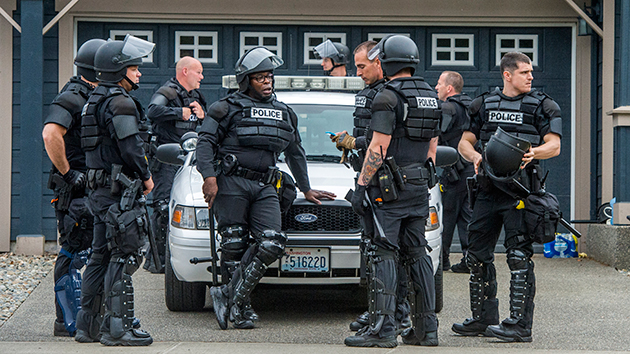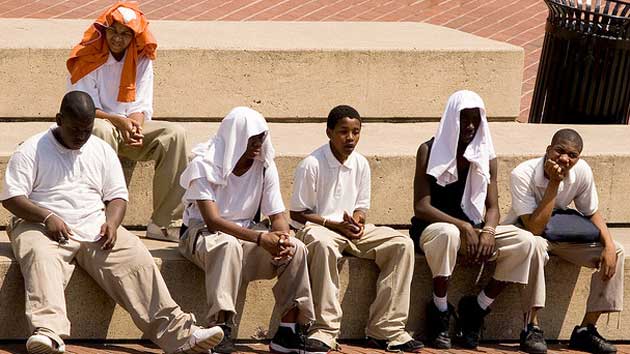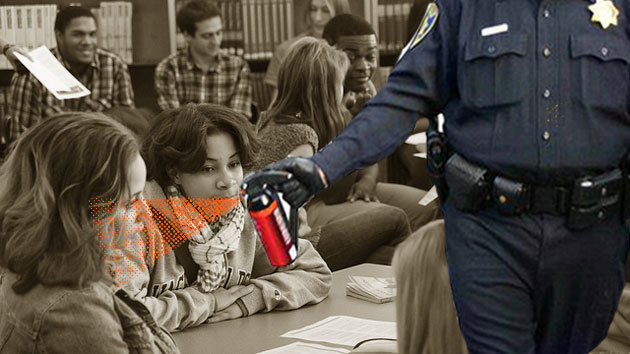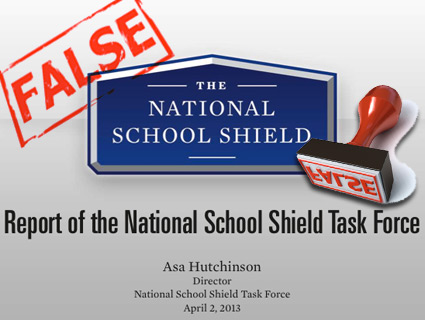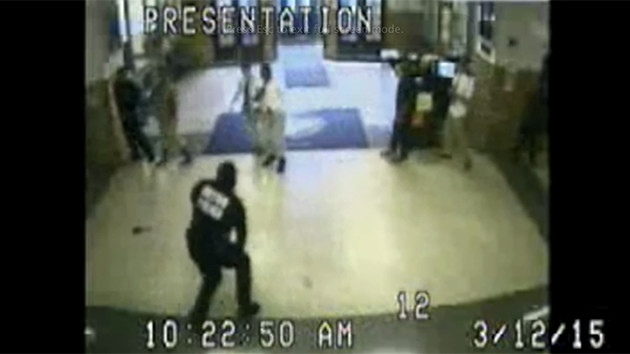
A Louisville police officer is facing assault and misconduct charges after his alleged use of force at a middle school.Screenshot from school surveillance footage
Over the past year, video footage from around the country of law enforcement officers killing citizens, many of them black, has brought scrutiny on policing in the streets. Yet, another disturbing police problem has drawn far less attention: Use of force by cops in schools. According to news reports and data collected by advocacy groups, over the past five years at least 28 students have been seriously injured, and in one case shot to death, by so-called school resource officers—sworn, uniformed police assigned to provide security on K-12 campuses.
As with the officer-involved killings that have been thrust into the national spotlight, government data on police conduct in schools is lacking. And while serious use of force by officers against school kids appears to be rare, experts also point to a troubling lack of training and oversight, and a disproportionate impact on minority and disabled students.
Here are some of the recent cases, which Mother Jones has looked into further:
- Chokehold and a brain injury: In March, Louisville Metro Police officer Jonathan Hardin was fired after his alleged use of force in two incidents at Olmsted Academy North middle school: He was accused of punching a 13-year-old student in the face for cutting the cafeteria line, and a week later of putting another 13-year-old student in a chokehold, allegedly knocking the student unconscious and causing a brain injury. In April, a grand jury indicted Hardin on assault and misconduct charges for the chokehold incident, and his trial is pending. The Jefferson County Attorney’s Office is also considering charges against Hardin over the punching incident, a spokesperson for the attorney’s office told Mother Jones. Hardin’s attorney declined to comment, citing the ongoing criminal litigation.
- Beating with a baton: In May 2014, Cesar Suquet, then a 16-year-old high school student in Houston, was being escorted by an officer out of the principal’s office after a discussion about Suquet’s confiscated cell phone. Following a verbal exchange, police officer Michael Y’Barbo struck Suquet at least 18 times with a police baton, injuring him on his head, neck and elsewhere, according to the lawsuit Suquet’s family filed against the Pasadena Independent School District. In its response to the incident (which was captured on video according to court documents), the school district admitted that Y’Barbo struck Suquet but denied allegations of wrongdoing. Y’Barbo, in his response, denied striking Suquet on the head, stating that he acted “within his discretionary duties” and that his use of force was “reasonable and necessary.” A spokesperson for the school district told Mother Jones that Y’Barbo remains on regular assignment including patrol.
- Taser-induced brain injury: In November 2013, student Noe Nino de Rivera was trying to break up a fight at Cedar Creek High School in Bastrop County, Texas, when two officers arrived and told Nino de Rivera to step back. Within moments, one of the officers, Randy McMillan, tased the 17-year-old, who fell to the ground and hit his head. Nino de Rivera was taken to a hospital, where he “underwent surgery to repair a severe brain hemorrhage and was placed in a medically induced coma,” according to the family’s lawsuit against McMillan, Bastrop County, and the school district. The teen remained in a coma for 52 days, a family attorney told CNN. Attorneys representing the county said that Nino de Rivera had failed to comply with orders and that McMillan “used the reasonable amount of necessary force to maintain and control discipline at the school.” In May 2014, a grand jury declined to indict McMillan, and that month he received a promotion. Three months later, the county agreed to pay Nino de Rivera’s family $775,000 to settle the lawsuit.
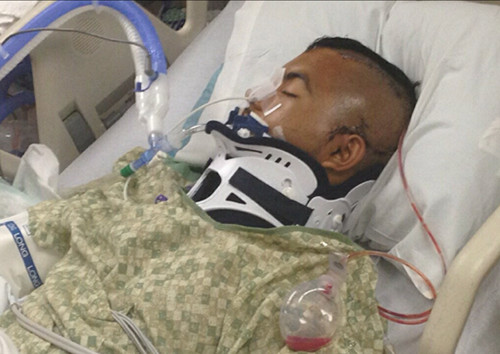
- Shot to death: On November 12, 2010, 14-year-old Derek Lopez stepped off a school bus outside of Northside Alternative High School, near San Antonio, and punched another student, knocking him to the ground. Officer Daniel Alvarado witnessed the altercation and ordered Lopez to freeze, and then chased a fleeing Lopez to a shed behind a house, where he fatally shot him. Alvarado later testified that Lopez had “bull-rushed” him as he opened the shed door. Lopez, who was unarmed, died soon afterward. In August 2012, a grand jury declined to indict Alvarado. The Northside Independent School District school board later agreed to pay a $925,000 settlement to Lopez’s family. Alvarado has since been terminated from Northside for unrelated reasons, an attorney for the school district told Mother Jones.
The US and state governments do not specifically collect data on police conduct in K-12 schools. But some data has been gathered at the county and state level by the ACLU and other advocacy groups, including in Texas and North Carolina. Using news reports, the Huffington Post identified at least 25 students in 13 states recently who sought medical attention after getting tased, peppersprayed, or shot with a stun gun by school resource officers. (For more on these harsh tactics and a lawsuit they led to, read this Mother Jones story.)
From the war on drugs to “zero tolerance policies,” cops have been utilized in K-12 schools for decades. But the mass shooting at Columbine High School in 1999 caused their ranks to swell, with the number of police officers patrolling K-12 campuses approximately doubling to 20,000 by 2006, according to the National Association of School Resource Officers. The US Department of Justice spent an estimated $876 million after Columbine to fund nearly 7,000 school resource officers across the country. Since the massacre at Sandy Hook Elementary in 2012, the DOJ has spent another $67 million to fund an additional 540 cops in schools. Many school districts and local police departments have funded their own sworn law enforcement personnel for the job.
But much about this field remains unclear: According to a recent report from Philip Stinson, a Bowling Green University criminologist, “The existing research offers few answers to such basic questions as to how SROs are selected, the nature and extent of SRO training, and the strategic uses of SROs.”
Michael Dorn, a former school district police chief in Georgia, says that misconduct cases by school cops are rare and that overall their presence has helped improve campus safety. But the programs need to be better evaluated based on data, he adds. Studies in some school districts have shown that school cops helped reduce crime, truancy, and bullying. But others have found that the presence of cops in schools leads to increased ticketing and arrests for minor infractions. Jason Langberg, an attorney in Virginia who has represented victims of alleged abuse, explains that many officers end up stepping into matters of routine student discipline. They deal with “minor scuffles, a bag of marijuana, or even just talking back,” he says. “The vast majority of incidents don’t involve guns in schools.”
Dewey Cornell, a psychology professor at the University of Virginia who studies school safety, suggests that the rise of school cops has been based on misguided fear. After Sandy Hook, the NRA proposed putting them in every single school in America. But relative to overall gun violence, “schools are one of the least likely places for a shooting to occur, and pulling officers off the street and putting them on guard in a school lobby is short-sighted and dangerous,” Cornell says. “The fear of school shootings has been greatly overestimated because of the attention to a handful of tragic cases.”
Last March, the US Department of Education reported that 92,000 students were subject to school-related arrests in the 2011-2012 academic year, the first time the agency collected and published such data. Black students comprised 16 percent of the total students enrolled but accounted for 31 percent of arrests. And a quarter of the total arrested were students with disabilities, despite that they comprised only 12 percent of the student population. In recommendations to the White House published in May, the President’s Task Force on 21st Century Policing advised that law enforcement agencies analyze data on all stops, frisks, searches, summons, and arrests—and seperate out the data for school detentions. “Noncriminal offenses can escalate to criminal charges when officers are not trained in child and adolescent development,” the report noted.
Often young police officers are on the job, according to the advocacy group Strategies for Youth, which works with police departments and school districts on training. Yet, a national survey conducted in 2013 by the group found that police academies in only one state, Tennessee, offered training specifically for officers deployed to schools. The majority of academies, the survey noted, “do not teach recruits how to recognize and respond to youth with mental health, trauma-related and special education-related disorders.”
In February, Michael Reynolds, a black high school student in Detroit, testified to the task force about an interaction with a cop at his school. “Before I could explain why I did not have my [student] badge I was escorted to the office and suspended for an entire week,” he said. “Many young people today have fear of the police in their communities and schools.”
